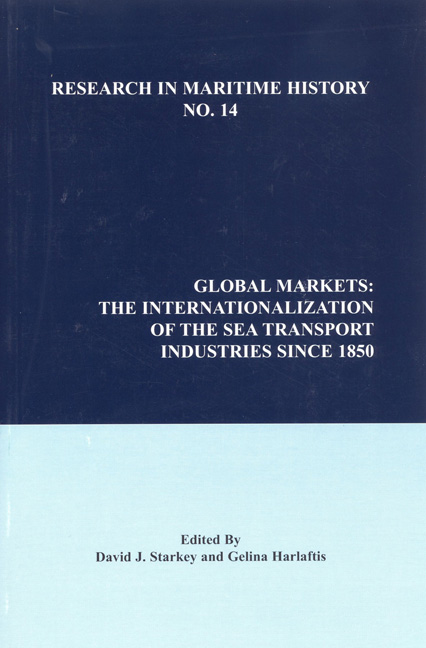Book contents
- Frontmatter
- Contents
- About the Editors
- Contributors
- Introduction
- “International Freight Markets in the 1830s and 1840s: The Experience of a Major Finnish Shipowner”
- “The First (and Very Secret) International Steamship Cartel, 1850-1856”
- “Competition or Co-operation in the Global Shipping Industry: The Origins and Impact of the Conference System for British Shipowners before 1914”
- “National Alliances and Global Webs: The Internationalization of Japanese Shipping”
- “Dutch Sea Transport in Transition: The German Hinterland as Catalyst, 1850-1914”
- “The Expansion of American Interests in Transatlantic Commerce and Trade, 1865-1893”
- “The Expansion of Japan's Shipping Interests before the Sino-Japanese War”
- “Cooperation and Reorganization on the North-South Routes from Japan in the Interwar Period”
- “The Global Communications Industry and Its Impact on International Shipping before 1914”
- “The Nineteenth-Century Roots of Globalization: Some Technological Considerations”
- “The Global Fish Market: Internationalization and Globalization, 1880-1997”
- “Convergence or National Styles? The Japanese Challenge to the British-Norwegian Hegemony in the Twentieth-Century Whaling Industry”
- “International Trends and Greek Shipping: The Business Strategy of Demetrios Moraitis, 1893-1908”
- “Organizational and Managerial Patterns of Greek- Owned Shipping Enterprises and the Internationalization Process from the Internar Period to 1990”
- “Internationalization and the Collapse of British Shipbuilding, 1945-1973”
- “Globalization and International Competitiveness: The Experience of the Japanese Shipping Industry since the 1960s”
- “Containerization and the Globalization of Liner Shipping“
“The First (and Very Secret) International Steamship Cartel, 1850-1856”
- Frontmatter
- Contents
- About the Editors
- Contributors
- Introduction
- “International Freight Markets in the 1830s and 1840s: The Experience of a Major Finnish Shipowner”
- “The First (and Very Secret) International Steamship Cartel, 1850-1856”
- “Competition or Co-operation in the Global Shipping Industry: The Origins and Impact of the Conference System for British Shipowners before 1914”
- “National Alliances and Global Webs: The Internationalization of Japanese Shipping”
- “Dutch Sea Transport in Transition: The German Hinterland as Catalyst, 1850-1914”
- “The Expansion of American Interests in Transatlantic Commerce and Trade, 1865-1893”
- “The Expansion of Japan's Shipping Interests before the Sino-Japanese War”
- “Cooperation and Reorganization on the North-South Routes from Japan in the Interwar Period”
- “The Global Communications Industry and Its Impact on International Shipping before 1914”
- “The Nineteenth-Century Roots of Globalization: Some Technological Considerations”
- “The Global Fish Market: Internationalization and Globalization, 1880-1997”
- “Convergence or National Styles? The Japanese Challenge to the British-Norwegian Hegemony in the Twentieth-Century Whaling Industry”
- “International Trends and Greek Shipping: The Business Strategy of Demetrios Moraitis, 1893-1908”
- “Organizational and Managerial Patterns of Greek- Owned Shipping Enterprises and the Internationalization Process from the Internar Period to 1990”
- “Internationalization and the Collapse of British Shipbuilding, 1945-1973”
- “Globalization and International Competitiveness: The Experience of the Japanese Shipping Industry since the 1960s”
- “Containerization and the Globalization of Liner Shipping“
Summary
The nineteenth-century internationalization of maritime industries is especially well demonstrated through the efforts of two leading steamship lines — one British, the other American — together with an Anglo- American banking firm of international eminence, to rationalize the competitive environment of mid-nineteenth century steam liner service on the major transatlantic shipping route for passengers and cargo. This effort to achieve stability, predictability, and profitability involved the creation of the first major international cartel in oceangoing steamship operations. A particularly distinctive and essential element of this cartel was the role of a transatlantic financial institution in both initiating and maintaining an arrangement that provided for the setting of minimum freight rates and sharing of revenues while serving to forestall direct competition from rival shipping firms on both sides of the Atlantic Ocean.
While this inter-firm shipping agreement was stipulated and enforced through a formal contractual arrangement, it was kept secret so successfully that both the agreement and its specific provisions were not known publicly until well over a century had elapsed. Consequently, historians of shipping conferences customarily date the initiation of such agreements among major steamship competitors at 1875, with the Calcutta Conference of steam liner companies trading between the United Kingdom and India. A slightly earlier attempt to create such a self-regulating association occurred in 1868 when several New York-based steamship lines formed the Transatlantic Shipping Conference; however, nothing of substance came from the efforts of these firms until 1902.
The first, and very secret, international steamship cartel had its origins in the late 1840s. At that time the British and North American Royal Steam Packet Company, known popularly as the Cunard Line in recognition of its promoter and largest single shareholder, Samuel Cunard, had operated successfully against both domestic and foreign competitors since beginning its transatlantic service in 1840. Now there was a new and dangerous challenge: the American-based New York and Liverpool United States Mail Steamship Company, which was being formed by a highly successful operator of transatlantic sailing packets, Edward Knight Collins.
This “Collins Line,” as it was customarily identified, was a major financial undertaking for its time. To compete directly with the well established Cunard Line required a fleet of ocean-going steamships of sufficient number and quality to attract a major portion of the transatlantic passenger and cargo business conducted between New York and Liverpool.
- Type
- Chapter
- Information
- Global MarketsThe Internationalization of The Sea Transport Industries Since 1850, pp. 29 - 52Publisher: Liverpool University PressPrint publication year: 1998



